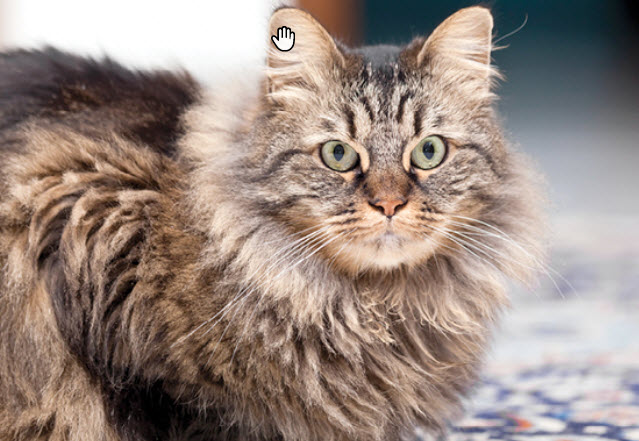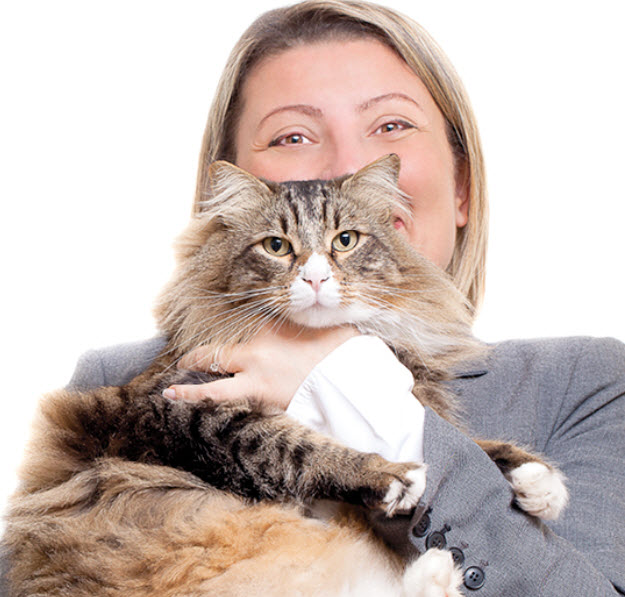
Learn About The Maine Coon Cat Breed From A Trusted Veterinarian
Your cat is special! She senses your moods, is curious about your day, and has purred her way into your heart. Chances are that you chose her because you like Maine Coons (sometimes called “Coon Cats”) and you expected her to have certain traits that would fit your lifestyle, like:
- Gentle-mannered and easy to get along with
- Large, strong, and athletic
- Highly intelligent and able to learn tricks
- Laid back - gets along with cat-friendly dogs and kids
- May purr when she is content
However, no cat is perfect! You may have also noticed these characteristics:
- Coat needs to be cared for frequently to prevent matting
- Very talkative, has an opinion about everything
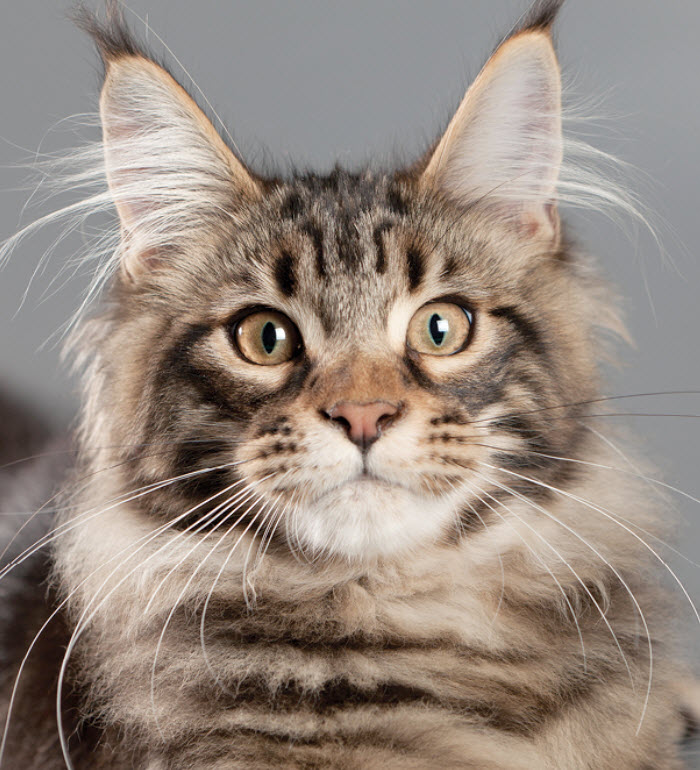
The Maine Coon is known for its large size and thick double coat of long hair which is well suited for the harsh winters in Maine, the state from which they originated. Relaxed and laid-back, Maine Coons are not overly dependent, but they are people oriented. They are happy to follow their owners from room to room, coming when called and playing fetch. Some Maine Coons are attracted to water and may even enjoy an occasional swim.
Your Maine Coon's Health
We know that because you care so much about your cat, you want to take great care of her. That is why we have summarized the health concerns we will be discussing with you over the life of your Maine Cat. By knowing about the health concerns common among Maine Coons, we can help you tailor an individual preventive health plan and hopefully prevent some predictable risks in your pet.
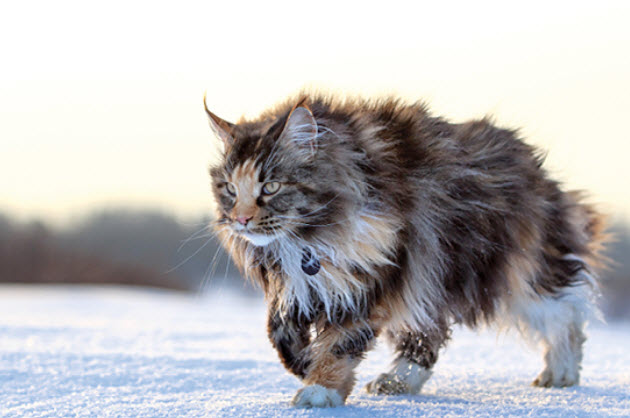
This guide contains general health information important to all felines as well as information on genetic predispositions for Maine Coons. The information here can help you and your pet’s healthcare team plan for your pet’s unique medical needs together. At the end of the article, we have also included a description of what you can do at home to keep your Coon Cat looking and feeling her best. We hope this information will help you know what to watch for, and we will all feel better knowing that we’re taking the best possible care of your friend.
General Health Information for your Maine Coon
Obesity is a major disease that contributes to a surprisingly large number of illnesses and deaths in cats.
This revelation is more well-known and well-understood today than in the last few decades, but too many owners are still ignoring the dangers of extra weight on their pets. Excess weight is one of the most influential factors in the development of arthritis, diabetes, and other life-threatening diseases. Everyone knows—many firsthand from personal experience—how even shedding just a few pounds can result in improved mobility and increased overall motivation to be active. And the same is true for your pet.
Research suggests that carrying excess weight may shorten a pet’s life by as much as two years, and can cause the onset of arthritis two years sooner. Diabetes, an inherited disease, has a much higher chance of developing in overweight pets, and may never become a problem for a healthy-weight cat. The more obese a cat becomes, the more likely it will become diabetic. Hepatic lipidosis, or fatty liver, is another potentially fatal disease in overweight pets; hepatic lipidosis can develop in as few as 48 hours when an overweight cat stops eating for any reason.
So how can we help our pets stay trim? Understanding your cat's dietary habits is key. The average cat prefers to eat about 10-15 times a day, just a few nibbles at a time. This method, free-feeding, works well for most cats, but boredom may increase the number of trips your cat makes to the food bowl. By keeping your cat playfully active and engaged, you'll help your pet stay healthy and have some fun at the same time! A string tied to a stick with something crinkly or fuzzy on the other end of the string, and a little imagination—you and your cat will both be entertained. Food puzzles, like kibbles put in a paper bag or under an overturned basket or box, may help to motivate cats with more food-based interests to romp and tumble.
For really tough cases of overeating, you will have to take a firm stance, and regulate your cat’s food intake. Instead of filling your cat’s bowl to the top, follow the feeding guide on the food package and be sure to feed a high-quality adult cat diet as recommended by your vet. Replace your cat's habits of eating when bored with extra playtime and affection. Cats typically adjust their desires for personal interaction by the amount of affection offered to them, so in other words, ignoring your cat means your cat will ignore you. By the same token, loving on and playing with your cat a lot will cause your cat to desire that time with you. A more active cat means a healthier, happier pet—and owner!
Dental Disease
Dental disease is one of the most common chronic problems in pets who don’t have their teeth brushed regularly. Unfortunately, most cats don’t take very good care of their own teeth, and this probably includes your Maine Cat. Without extra help and care from you, your cat is likely to develop potentially serious dental problems. Dental disease starts with food residue, which hardens into tartar that builds up on the visible parts of the teeth, and eventually leads to infection of the gums and tooth roots. Protecting your cat against dental disease from the start by removing food residue regularly may help prevent or delay the need for advanced treatment of dental disease. This treatment can be stressful for your cat and expensive for you, so preventive care is beneficial all around. In severe cases of chronic dental infection, your pet may even lose teeth or sustain damage to internal organs. And, if nothing else, your cat will be a more pleasant companion not knocking everyone over with stinky cat breath! We’ll show you how to keep your cat's pearly whites clean at home, and help you schedule regular routine dental exams.
Vaccine-Preventable Infections
Like all cats, Maine Coons are susceptible to bacterial and viral infections such as panleukopenia, calicivirus, rhinotracheitis, and rabies, which are preventable through vaccination. The risk of your cat contracting these diseases is high, so the corresponding vaccines are called “core” vaccines, which are highly recommended for all cats. In addition, vaccines are available to offer protection from other dangerous diseases like feline leukemia virus (FeLV). In making vaccination recommendations for your cat, we will consider the prevalence of these diseases in the Cat Care Center of Baton Rouge area, your cat’s age, and any other risk factors specific to her lifestyle.
Parasites
All kinds of worms and bugs can invade your Coon Cat's body, inside and out. Everything from fleas and ticks to ear mites can infest her skin and ears. Hookworms, roundworms, heartworms, and whipworms can get into her system in a number of ways: drinking unclean water, walking on contaminated soil, or being bitten by an infected mosquito. Some of these parasites can be transmitted to you or a family member and are a serious concern for everyone. For your feline friend, these parasites can cause pain, discomfort, and even death, so it’s important that we test for them on a regular basis. Many types of parasites can be detected with a fecal exam, so it’s a good idea to bring a fresh stool sample (in a stink-proof container, please) with your pet for her twice-a-year wellness exams. We’ll also recommend preventive medication as necessary to keep her healthy.
Spay or Neuter
One of the best things you can do for your Maine Cat is to have her spayed (neutered for males). In females, this procedure includes surgically removing the ovaries and usually the uterus; in males, the testicles are surgically removed. Spaying or neutering your pet decreases the likelihood of certain types of cancers and eliminates the possibility of your pet becoming pregnant or fathering unwanted litters. Both sexes usually become less territorial and less likely to roam, and neutering particularly decreases the occurrence of urine spraying and marking behaviors in males. Performing this surgery also gives us a chance, while your pet is under anesthesia, to identify and address some of the diseases your cat is likely to develop. For example, if your pet needs hip X-rays to check for dysplasia or a thorough dental exam to look for stomatitis, these procedures can be conveniently performed at the same time as the spay or neuter to minimize the stress on your cat. Routine blood testing prior to surgery also helps us to identify and take precautions against common problems that increase anesthetic or surgical risk. It sounds like a lot to keep in mind, but don’t worry - we’ll discuss all the specific problems we will look for with you when the time arrives.
Genetic Predispositions for Maine Coons
Heart Disease
Cardiomyopathy is the medical term for heart muscle disease, either a primary inherited condition or secondary to other diseases that damage the heart. The most common form, called hypertrophic cardiomyopathy, or HCM, is a thickening of the heart muscle often caused by an overactive thyroid gland. Another example is dilated cardiomyopathy, or DCM, which can be caused by a dietary deficiency of the amino acid taurine. While DCM was a big problem in the past, all major cat food producers now add taurine to cat food, so DCM is rarely seen in cats with high-quality diets today.
Catching signs of cardiomyopathy early is important, but a cat's normal tendency to hide illness can make symptoms difficult to spot. The first thing a pet parent usually notices is rapid breathing, lethargy, and a poor appetite. These symptoms may appear to come on suddenly, often between a few hours to a few days, but in most cases, the cat has actually been suffering quietly for weeks to months and is now in serious trouble. In addition, HCM can cause blood clots to form inside the heart. These clots can then leave the heart and become lodged in the major arteries that transport blood to the rear legs. If this happens, the cat will suddenly lose the use of both rear legs and the tail—the legs will become cold to the touch and will seem extremely painful. In either case, whether rapid breathing or painful paralysis, the cat is experiencing a medical emergency, and needs immediate veterinary care.
For a few breeds of cats, genetic testing is available for a specific gene abnormality that causes HCM. Most cats with cardiomyopathy have a heart murmur that can be detected during a wellness physical exam, but a specific diagnosis requires more advanced medical imaging. Finding this problem early, when treatment is most effective, is another important reason to have your pet evaluated twice a year for life.
Patellar Luxation
The stifle, or knee joint, is a remarkable structure that allows a cat to perform amazing feats of agility like crouching, jumping, and pouncing. One of the main components of the stifle is the patella, or kneecap, and the medical term luxation means “being out of place”. Thus, a luxating patella is a kneecap that slips off to the side of the leg because of an improperly developed stifle. A cat with a luxating patella may not show signs of pain or abnormality until the condition is well advanced; signs of this condition appear gradually and can progress to lameness as the cat grows older. Early detection of a luxating patella is key to effective therapy, so getting your cat an x-ray at the time of her spay or his neuter, around three to six months of age, is a good way to check. If the problem is mild and involves only one leg, your pet may not require much treatment beyond typical arthritis medication. When symptoms are more severe, surgery may be needed to realign the kneecap and prevent it from popping out of place. Although the tendency for patellar luxation seems to be inherited, developmental problems in joints have complex inheritance patterns, and genetic tests have not yet been developed for this condition. Patellar luxation occurs in many breeds, but Coon Cats are at higher risk for the condition.
Most commonly seen in dogs, hip dysplasia may also occur in cats, especially in Maine Coons. Dysplasia is an inheritable condition that causes malformation of the hip joints and subsequent arthritis. Usually a cat shows very few clinical symptoms as an adolescent, but begins slowing down and acting like an older cat prematurely within the first few years. Severely affected cats, however, may show lameness by six months of age. Pelvic X-rays are needed to detect early hip dysplasia; cats should be anesthetized or sedated for this procedure, in part because the radiograph machine is a frightful and stressing situation for cats, but also because X-rays of the pelvis should be taken while the cat is perfectly still. Anesthesia allows for proper positioning of the cat to produce a clear, diagnostic radiograph, without the pain and fear most cats experience with X-rays, especially if they already have sore hips. Hip dysplasia is best treated when detected early, so initial X-rays of the hips are recommended at the time of your kitten's spay or neuter, usually around three to six months of age. X-rays can also be conveniently scheduled at the time of your cat’s annual dental cleaning in order to minimize the number of anesthetic events your cat undergoes. If necessary, hip dysplasia can be alleviated by surgical restructuring of the pelvis to help relieve pain and allow greater mobility for your affected cat. Because the disease is genetic, if you are purchasing a purebred kitten, be sure to ask your breeder whether the parents’ hips have been X-rayed.
Gingivitis
Gingivitis is inflammation of the gingiva, or gums. Just like in people, it causes redness and pain in the gums and is often linked to other diseases. In mild cases, gingivitis can be treated with a mouth rinse and represents only a minor problem, but without treatment it can progress to more severe afflictions such as periodontal disease or stomatitis. Gingivitis has also been associated with resorptive lesions and retrovirus infections such as the feline leukemia virus (FeLV) and the feline immunodeficiency virus (FIV). One of the best things you can do for your friend is to have his mouth evaluated by us often. Remember, cats are superstar actors and are great at masking illnesses, so you may not realize he is having any oral problems at all without an examination. With our trained healthcare team, we can safely look in his mouth to see if he is experiencing any pain or tooth trouble. Even though your cat may look great and act normally, he may be hiding a real problem in the back of his mouth!
Renal Failure
Renal failure refers to the inability of the kidneys to properly perform their functions of cleansing waste from the blood and regulating hydration. Kidney disease is extremely common in older cats, but is usually due to exposure to toxins or genetic causes in young cats. Even very young kittens can have renal failure if they have inherited kidney defects, so we recommend screening for kidney problems early, before any anesthesia or surgery, and then regularly throughout life. Severe renal failure is a progressive, fatal disease, but special diets and medications can help cats with kidney disease live longer, fuller lives.
Blood Type
Although we hate to think of the worst happening to our pets, when disaster strikes, it’s best to be prepared. One of the most effective life-saving treatments available in emergency medicine today is the use of blood transfusions. If your cat is ever critically ill or injured and in need of a blood transfusion, the quicker the procedure is started, the better the pet's chance of survival.
Just like people, individual cats have different blood types. Most domestic cats have type A blood, but purebred cats, like your Maine Coon often have a different blood type, usually type B or very rarely, type AB. Determining your cat's blood type is essential before starting a transfusion, so knowing your cat’s type ahead of time can save crucial minutes. Blood typing is recommended for all cats, but is especially important for purebreds. This test can be done as part of a routine wellness blood testing, and the results can be added to your pet's microchip record as well for fast action even if you aren't there.
Deafness
Cats of any breed that are completely white, especially if they have blue eyes, are at high risk for congenital deafness, and are likely to be born with reduced or absent hearing. Heritable or genetic deafness has also been noted in some Coon Cat bloodlines, so if you suspect your cat's hearing is not as keen as it should be, schedule an appointment with us right away. The problem could be caused by a treatable issue like ear polyps or an ear infection, but if your pet's ears are healthy and he's still ignoring you, a more thorough hearing workup might be in order, including brainwave analysis, if indicated. There is no treatment for genetic nerve deafness, but most deaf cats get along fine in an indoor environment. For deaf or hearing-deficient cats, going outside can be very dangerous, as cats rely largely on hearing to detect sneaking predators and other perils like oncoming cars, so an indoor life is the best way to keep your hard-of-hearing pet safe.
Taking Care of Your Maine Coon at Home
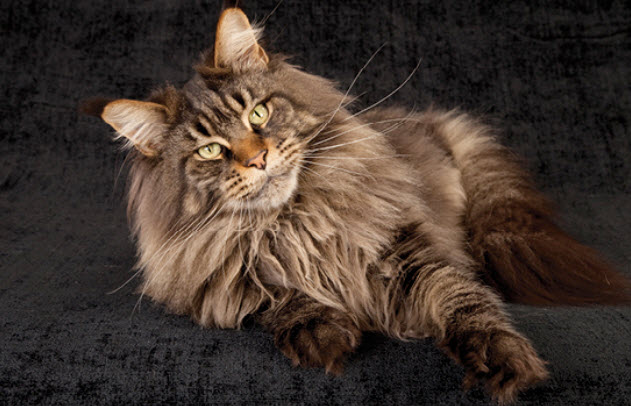
Routine Care, Diet, and Exercise
Build your pet’s routine care into your schedule to help your Coon Cat live longer, stay healthier, and be happier during her lifetime. We cannot overemphasize the importance of a proper diet and exercise routine for your pet.
- Supervise your pet as you would a young child. Keep doors closed, pick up after yourself, and block off rooms as necessary. This will help keep her out of trouble, off of inappropriate surfaces for jumping, and away from objects she shouldn’t put in her mouth.
- She has long hair that will need brushing daily.
- Maine Coons have generally good teeth, and you can keep them perfect by brushing them at least twice a week!
- Check her ears weekly for wax, debris, or signs of infection and clean when necessary. Don’t worry—we’ll show you how!
- She needs daily play sessions that stimulate her natural desire to hunt and explore. Keep her mind and body active or she may develop behavior issues.
- Cats are meticulously clean and demand a clean litter box. Be sure to provide at least one box for each cat and scoop waste daily.
- It is important that your cat drinks adequate amounts of water. If she won’t drink water from her bowl try adding ice cubes or a flowing fountain.
- Feed a high-quality feline diet appropriate for her age.
- Exercise your cat regularly by engaging her with high-activity toys.
What to Watch For
An abnormal symptom in your pet could be just a minor or temporary issue, but it could also be the sign of serious illness or disease. Knowing when to seek veterinary help, and how urgently, is essential to taking care of your cat. Many diseases can cause cats to have a characteristic combination of symptoms, which together can be a clear signal that your Maine Coon needs help.
Office Calls
Give us a call for an appointment if you notice any of these types of symptoms:
- Change in appetite or water consumption
- Tartar build-up, bad breath, red gums, or broken teeth
- Itchy skin (scratching, chewing, or licking), hair loss, or areas of shortened fur
- Lethargy, mental dullness, or excessive sleeping
- Fearfulness, aggression, or other behavioral changes
- Limping, reluctance to jump when playing
- Lameness, abnormal hind limb gait, “bunny hopping”
- Poor appetite, weight loss, lethargy, increased thirst and urination
- Lack of response to noises
Emergencies
Seek medical care immediately if you notice any of these signs:
- Scratching or shaking the head, tender ears, or ear discharge
- Cloudiness, redness, itching, or any other abnormality involving the eyes
- Inability or straining to urinate; discolored urine
- Weakness or exercise intolerance; rapid, labored, or open-mouth breathing; sudden-onset of weakness
Link nội dung: https://bitly.vn/learn-about-the-maine-coon-cat-breed-from-a-trusted-veterinarian-a12859.html
